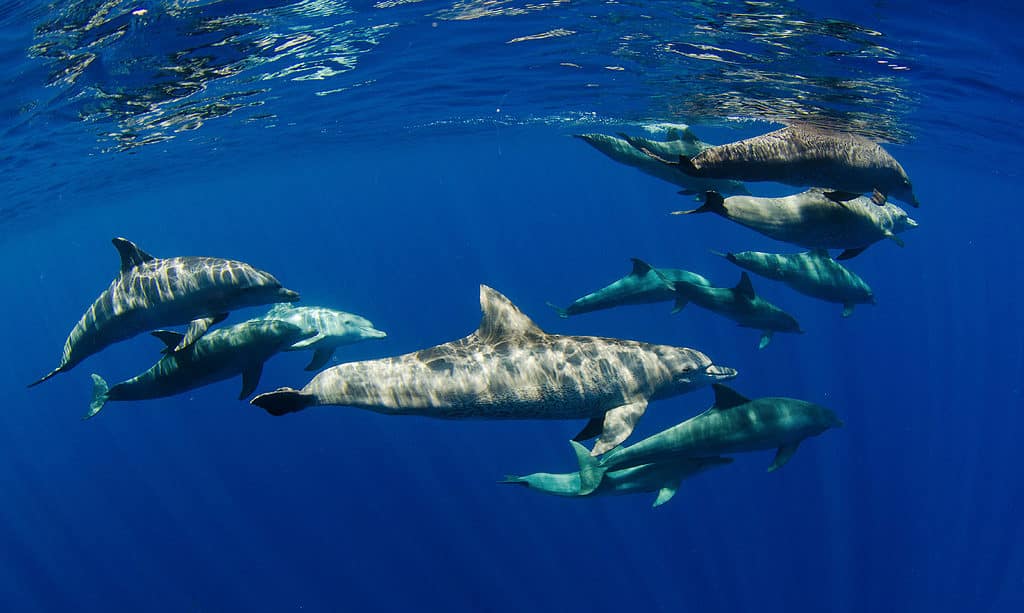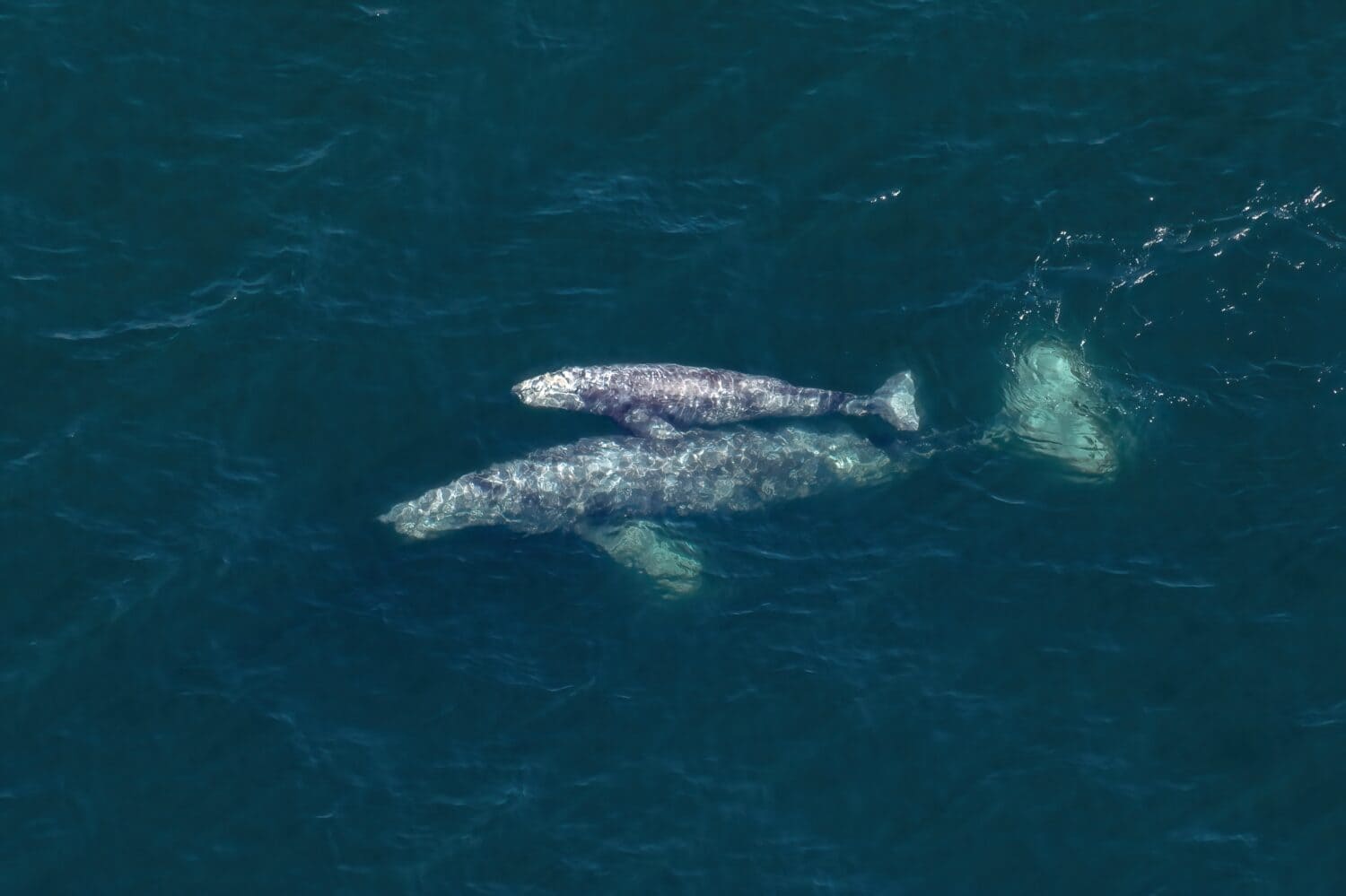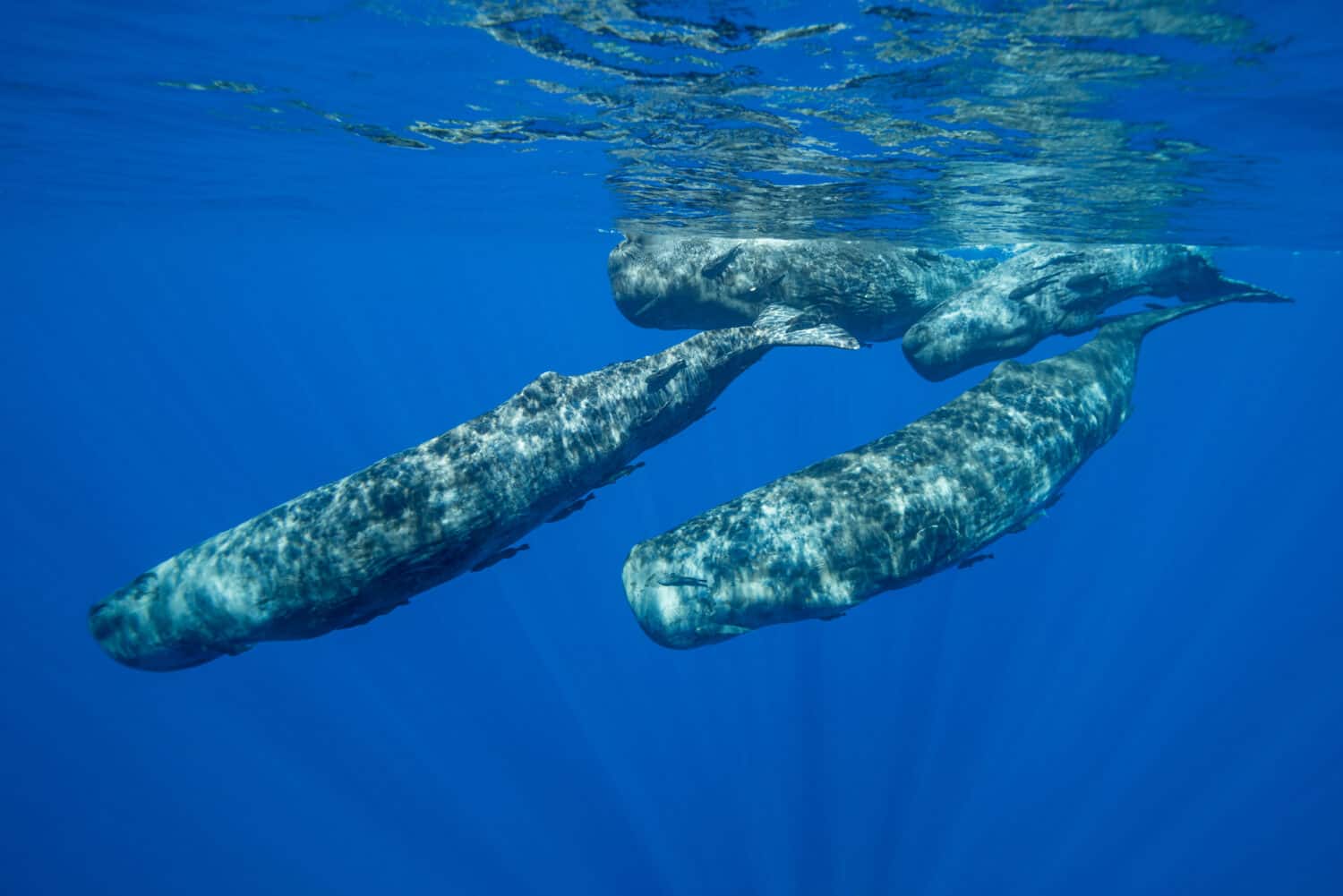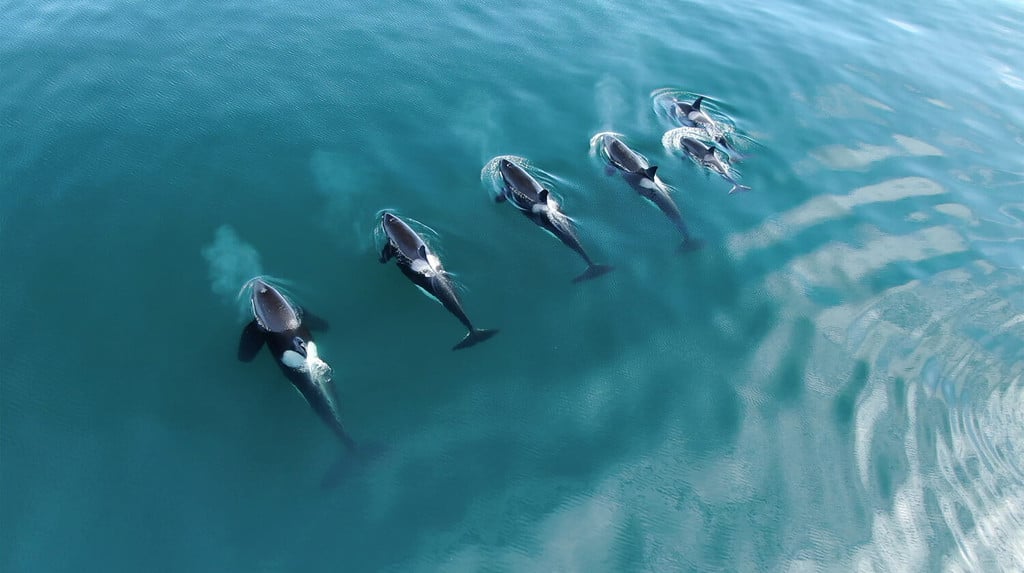San Francisco Bay, along the picturesque California coastline, offers a unique window into the world of marine mammals. Amidst its waters, you can spot a variety of seven whale species near or in the bay in search of food. At the same time, you can also spot 22 other species in the open ocean off the coast. These majestic creatures, some common or moderately rare, while others are incredibly elusive, contribute to this coastal region’s rich biodiversity and allure. This article will explore in depth the seven whales you will most likely see in or near San Francisco Bay and 22 whales inhabiting the North Pacific Ocean near San Francisco Bay.
Whales Most Often Seen in San Francisco Bay
Humpback Whale (Megaptera novaeangliae)
The scientific name of the Humpback Whale is Megaptera novaeangliae. It is a remarkable marine species frequently encountered near San Francisco Bay. They are often seen from May through November.
The Humpback Whale, a baleen whale species, is characterized by their distinctive appearance. They have long, dark bodies with large pectoral fins, and each can span longer than 15 feet, hence their scientific name, Megaptera, meaning large-winged. These fins make them incredibly assertive swimmers, allowing them to swim and breach the water’s surface easily. Moreover, adult Humpback Whales can measure approximately 14 to 17 meters (46 to 56 feet) in length and weigh upwards of 40 metric tons (88,000 pounds).
Best Time to See Them
The prime time to spot Humpback Whales in or near San Francisco Bay is from December through May. During these months, they migrate to the area to breed, calve, and nurse their young, as they prefer shallow and warm waters that are often near shores or offshore reef systems. They have also been known to venture into San Francisco Bay to feed. Winter is an ideal time to view them, especially in the form of whale watching tours, or if you are lucky, spot them from shore.
Humpback Whales are relatively common in the San Francisco Bay area during their migration season. Their numbers in this area have also increased over recent years, making sightings more frequent and accessible.
Migration and Feeding Habits
Humpback Whales live through major oceans worldwide. During their season migration, they can travel great distances. Some populations can travel upwards of 5,000 miles annually between their high-latitude summer feeding grounds to their winter calving grounds in warmer waters. They can average swimming roughly 100 to 150 miles per day during these journeys. San Francisco Bay serves as a vital stopover for certain populations.
According to the National Oceanic and Atmospheric Administration, their primary diet consists of schooling fish, krill, copepods, and plankton. Humpback Whales are known for their unique feeding technique called bubble-net feeding, where they create a ring of bubbles to trap their prey, then swim up through the center with mouths wide open, engulfing their meal.
Interesting Facts About Humpback Whales
Humpback Whales are renowned for their intricate songs that can last hours. These songs are related to mating and complex communication. Moreover, they are among the most acrobatic of all whale species, often breaching (jumping out of the water) and slapping their fins and tails, providing a captivating spectacle for whale watchers. Finally, Humpback Whales are known for their altruistic behavior, often seen rescuing other animals being preyed on or simply sharing their company.

In more recent years, Humpback Whales have been venturing into San Francisco Bay during their migration season.
©Tomas Kotouc/Shutterstock.com
Harbor Porpoise (Phocoena phocoena)
The scientific name of the Harbor Porpoise is Phocoena phocoena. It is a small species, and a resident population calls the waters around San Francisco Bay their home year-round. These smaller-than-average whales are generally shy and elusive by nature.
Harbor Porpoises are relatively small in size while also being robust. They typically range from 1.4 to 1.9 meters (4.7 to 6.3 feet) in length, with a maximum weight of approximately 76 kilograms (168 pounds). They have a sleek, grayish-blue dorsal side and a lighter, whitish belly with gray stripes. Their sides are a slightly lighter gray with light speckling. These porpoises lack a prominent beak, which distinguishes them from dolphins.
Best Time to See Them
One of the unique aspects of Harbor Porpoises is that they can be observed in or near San Francisco Bay throughout the year, making them a constant presence for those fortunate enough to spot them from land or by boat.
While less well-known than some other species, Harbor Porpoises are frequently observed by those who explore the waters around San Francisco Bay. Their populations in the area remain relatively stable. They are most active in San Francisco Bay in the summer and autumn.
Migration and Feeding Habits
A population of Harbor Porpoises are considered residents in this region, which means they do not embark on long migrations like some other whale species. They are typically found in nearshore waters and bays. Their diet primarily consists of small schooling fish, squid, and crustaceans, making them important predators in the local marine food web.
Interesting Facts about Harbor Porpoises
Harbor Porpoises are known for their rapid swimming and quick, erratic movements when surfacing. Moreover, they are a more solitary species, seen alone or in groups no larger than five individuals. Finally, they tend to be relatively sedentary species. They are highly sensitive to changes in their habitat, which can make them indicators of environmental health.

Harbor Porpoises are one of the smallest species of
porpoise
.
©ErnstS/Shutterstock.com
Bottlenose Dolphins (Tursiops truncates)
The scientific name of Bottlenose Dolphins is Tursiops truncatus. They are charismatic marine mammals that are curious and playful by nature and have high intelligence. A local population of dolphins are residents, meaning they reside in the area year-round.
Bottlenose Dolphins are medium-sized species with a sleek, grayish body. They are known for their prominent “bottlenose,” which is a distinctive elongated rostrum. This rostrum contains sharp teeth, ideal for catching their prey. They can weigh between 150 to 650 kilograms (330 to 1,430 pounds) and grow to lengths over 4 meters (13 feet).
Best Time to See Them
One of the remarkable aspects of Bottlenose Dolphins is the recent resident population in the waters in and around San Francisco Bay. This makes them a familiar sight for those exploring the region’s coastal waters by boat or from shore.
Boaters and marine enthusiasts in the area frequently encounter Bottlenose Dolphins. Their playful behavior and affinity for riding the bow waves of boats make them more common to observe. They are particularly active during the summer months.
Migration and Feeding Habits
These dolphins do not undertake long migrations, such as other whale species. They tend to stay in coastal and offshore waters where they can find abundant prey. They inhabit harbors, estuaries, bays, gulfs, nearshore coastal waters, and open ocean.
Bottlenose Dolphins are carnivores and opportunistic feeders, preying on various fish species. They use their echolocation abilities to locate and capture their meals. Their diet primarily consists of squid, shrimp, mollusks, and cuttlefish.
Interesting Facts About Bottlenose Dolphins
Bottlenose Dolphins are highly social animals, often found in groups called pods. These pods can consist of a few individuals to several dozen. Moreover, they are known for their playful behavior, which includes leaping out of the water, riding waves, and playing with natural objects and marine debris. Finally, Bottlenose Dolphins have complex communication systems, using a variety of clicks, whistles, and body language to communicate with one another.

Bottlenose Dolphins can be spotted in San Francisco Bay year-round.
©Joost van Uffelen/Shutterstock.com
Whales Most Often Seen Outside of San Francisco Bay
Gray Whale (Eschrichtius robustus)
The Gray Whale is a magnificent species of baleen whale known for its impressive annual migrations, with the eastern North Pacific stock migrating along the west coast of North America. These gentle giants are often spotted in the open ocean near San Francisco Bay and not in the bay itself.
Gray Whales can grow to lengths of 14.9 meters (49 feet) and weigh upwards of 41 metric tons (90,000 pounds). Moreover, they can live between 55 and 80 years on average. They have dark slate-gray skin with gray patches and white mottling and are often covered in barnacles and parasites. They have a streamlined body, two blowholes resembling a distinctive heart shape, and they lack a dorsal fin.
Best Time to See Them
The best time to spot Gray Whales near San Francisco Bay is from December through May. During this period, they undertake one of the longest migrations of any mammal, traveling from their feeding grounds in the Arctic to their breeding and calving areas around Baja California, Mexico.
Gray Whales are relatively common in the open ocean near San Francisco Bay during their migration season. Whale-watching tours offer excellent opportunities to observe these giants up close while respecting their space.
Migration and Feeding Habits
Gray Whales are migratory species, covering a distance of over 10,000 miles during their annual journey. They feed primarily on bottom-dwelling organisms such as amphipod crustaceans, which they filter from the sediment using their baleen plates. Furthermore, during their migration, Gray Whales only feed sparingly, if at all. Instead, they rely on stored fat reserves to help sustain them throughout the long journey.
Interesting Facts About Gray Whales
Gray Whales are known for their friendly and curious behavior, often approaching boats and allowing for close encounters. Moreover, they have a unique feeding strategy known as “bottom feeding,” where they turn on their sides and scoop up sediment from the ocean floor, trapping their prey in their baleen plates.

Gray Whales are one of the more friendly and curious species of whales.
©Travis Potter/Shutterstock.com
Sperm Whale (Physeter macrocephalus)
The Sperm Whale is a giant whale species famous for its massive head and unique deep-water diving habits. While they are often seen in the open ocean near San Francisco Bay, sightings are less common than some other species.
Sperm Whales are the largest toothed whales on Earth. They can reach lengths of 10.6 to 19 meters (35 to 62 feet), with males generally larger. Moreover, they can weigh upwards of 45 metric tons (99,000 pounds). They are easily recognizable by their enormous block-shaped head, which houses a spermaceti organ filled with a waxy substance called spermaceti. Furthermore, their heads can be up to one-third of their length.
Best Time to See Them
Sperm Whales are most often spotted in the waters near San Francisco Bay from December through May. During these months, they migrate along the California coast in search of squid, their primary prey.
Sperm Whale sightings in this region are less frequent compared to other whale species. However, dedicated whale-watching tours allow enthusiasts opportunities to potentially catch a glimpse of these magnificent creatures.
Migration and Feeding Habits
Sperm Whales are considered somewhat migratory in this area, moving along the coast in search of their ideal prey. They inhabit all of the world’s oceans, and their migratory habits are not well understood. Females and juveniles tend not to migrate, staying in warmer waters, while males are known to migrate to colder waters. They are also deep divers, known to descend to great depths well below 8,000 feet.
Sperm Whales have a diet primarily consisting of squid, sharks, skates, and fish. They use their powerful jaws and sharp teeth to capture and consume their prey, predominately hunting at significant depths.
Interesting Facts About Sperm Whales
Sperm Whales are renowned for their ability to dive to astonishing depths, often exceeding 8,000 to 10,000 feet in search of food. Moreover, the spermaceti, or liquid waxes in their head, was historically prized and was used in products such as oil lamps, candles, and lubricants.

The head of a Sperm Whale can measure approximately one-third of its body length.
©wildestanimal/Shutterstock.com
Orcas or Killer Whales (Orcinus orca)
Orca Whales, or Killer Whales, are apex predators of the ocean, known for their intelligence and complex social structures. These powerful marine mammals are often seen in the open ocean near San Francisco Bay.
Orcas are easily recognizable by their striking black-and-white coloration. They have a sleek, streamlined body and a distinctive dorsal fin that can reach impressive heights, especially in adult males. They average lengths of 5 to 8 meters (16 to 26 feet) and weigh more than ten metric tons (22,000 pounds).
Best Time to See Them
Orcas are most frequently observed in the waters near San Francisco Bay from December through May. During this period, they are known to travel along the California coast.
While not increasingly common, Orcas are still regularly spotted by boaters and whale-watching tours in the region. Their powerful presence and fascinating behaviors make them a sought-after sight.
Migration and Feeding Habits
Orcas are considered migratory in this area, following food sources rather than seasonal patterns. However, food sources tend to be more abundant in this area between December through May. They are skilled hunters and employ sophisticated group tactics when hunting. They are formidable predators with a diverse diet that varies depending on their location. Orcas target a wide range of marine species, including various mammals, such as other whales and seabirds, fish, squid, and even sharks.
Interesting Facts About Orca Whales
Orcas are often referred to as “killer whales” due to their predatory nature. However, they are the largest species of dolphin. Moreover, it is worth noting that all dolphins are indeed whales. These highly social animals live in close-knit family groups called pods, with distinct cultural behaviors and dialects among different pods. They are known for their intelligence and complex social structures. Moreover, Orcas are known for their incredible hunting strategies, such as wave-washing, where they create waves to wash seals off ice floes.

Orcas Whales, or Killer Whales, are apex predators.
©Willyam Bradberry/Shutterstock.com
Blue Whale (Balaenoptera musculus)
The Blue Whale is another baleen whale with an immense size and a majestic presence in the world’s oceans. While these gentle giants are not commonly seen in the San Francisco Bay, you can often spot them in the open ocean near the bay.
Blue Whales are the largest animals on Earth, with some individuals reaching lengths of up to 100 feet or more and weighing upwards of 199 metric tons (440,000 pounds). They have predominantly blue-gray and incredibly long bodies, with a lighter belly, mottled patches, and a distinct dorsal fin.
Best Time to See Them
The best time to spot Blue Whales near San Francisco Bay is typically from July through October. During this period, they follow their migratory route along the Pacific coast, where they prefer to feed, which may bring them into the vicinity of the bay.
While not as common as some other whale species, Blue Whales can be encountered by those venturing into the open ocean near San Francisco Bay. Whale-watching tours and boaters have the privilege of witnessing these magnificent giants of the sea.
Migration and Feeding Habits
Blue Whales are both migratory and resident species, traveling distances in search of food. Some populations have been known to undertake long migrations between their feeding and breeding grounds.
These immense whales are filter feeders, primarily consuming krill, a tiny shrimp-like organism. They engulf large quantities of water containing krill and then use their baleen plates to filter out the prey, expelling the water.
Interesting Facts About Blue Whales
Blue Whales are typically solitary animals but can occasionally be seen in small groups. Moreover, the heart of a Blue Whale can be as large as a cow, and its tongue alone can weigh as much as an elephant. Finally, Blue Whales are capable of producing one of the loudest sounds in the animal kingdom. Their sounds can reach 180 decibels.

Blue Whales Are the largest whales on Earth and can measure up to 100 feet in length.
©Andrew Sutton/Shutterstock.com
Whales Inhabiting the North Pacific Ocean Outside of San Francisco Bay
Of the variety of whales you might spot in San Francisco Bay, there is also an incredible variety residing in the adjacent open ocean. A variety of whale species can be spotted in the North Pacific Ocean off of San Francisco Bay. However, they range from moderately to incredibly rare. Among these species is the Fin Whale, recognized for its size and asymmetrical coloration. With its slender form and distinctive dorsal fin, the Sei Whale graces these seas, though sightings are rare. The Minke Whale, smaller in comparison, has a sleek profile. There are also the North Pacific Right Whale, Short-finned Pilot Whales, Pygmy Sperm Whales, and Dwarf Sperm Whales, which tend to be cryptic and rarely sighted.
Moreover, there are the Cuvier’s Beaked Whale, Baird’s Beaked Whale, Hubb’s Beaked Whale, Blainville’s Beaked Whale, and Stejneger’s Beaked Whale. In addition, the False Killer Whale, resembling Orca Whales, is another incredibly rare visitor.
Furthermore, the North Pacific Ocean is home to an array of dolphins, each with its distinguishing traits. Among these are the Pacific White-sided Dolphin, Dall’s Porpoise, Northern Right Whale Dolphin, Short-beaked Common Dolphin, Long-beaked Common Dolphin, Striped Dolphin, Spotted Dolphin, Rough-toothed Dolphin, and Risso’s Dolphin. These dolphins vary in commonality, with some being more frequently sighted than others. Yet, all contribute to the vibrant marine life of the region, offering unique and captivating encounters for those fortunate enough to spot them.

Minke Whales can be spotted off the coast of San Francisco.
©Tim Watters/Shutterstock.com
List of Whales You Might Spot in or Near San Francisco Bay
| Whale | Scientific Name | Best Time To See | Location Most Likely To See |
|---|---|---|---|
| Humpback Whale | Megaptera novaeangliae | May through November | San Francisco Bay or Open Ocean |
| Harbor Porpoise | Phocoena phocoena | Year-round / Summer and Autumn | San Francisco Bay or Open Ocean |
| Bottlenose Dolphins | Tursiops truncates | Year-round / Summer and Autumn | San Francisco Bay or Open Ocean |
| Gray Whale | Eschrichtius robustus | December through May | Open Ocean |
| Sperm Whale | Physeter macrocephalus | December through May | Open Ocean |
| Orca Whale or Killer Whale | Orcinus orca | December through May | Open Ocean |
| Blue Whale | Balaenoptera musculus | July through October | Open Ocean |
| False Killer Whale | Pseudorca crassidens | Year-round | Open Ocean |
| Pacific White-sided Dolphin | Lagenorhynchus obliquidens | Year-round | Open Ocean |
| Dall’s Porpoise | Phocoenoides dalli | Year-round | Open Ocean |
| Northern Right Whale Dolphin | Lissodelphis borealis | Year-round | Open Ocean |
| Short-beaked Common Dolphin | Delphinus delphis | Year-round | Open Ocean |
| Long-beaked Common Dolphin | Delphinus capensis | Year-round | Open Ocean |
| Striped Dolphin | Stenella coeruleoalba | Year-round | Open Ocean |
| Spotted Dolphin | Mirounga angustirostris | Year-round | Open Ocean |
| Rough-toothed Dolphin | Steno bredanensis | Year-round | Open Ocean |
| Risso’s Dolphin | Grampus griseus | Year-round | Open Ocean |
| Blainville’s Beaked Whale | Mesoplodon densirostris | Winter | Open Ocean |
| Stejneger’s Beaked Whale | Mesoplodon stejnegeri | Winter | Open Ocean |
| Fin Whale | Balaenoptera physalus | Winter | Open Ocean |
| Sei Whale | Balaenoptera borealis | Year-round | Open Ocean |
| Minke Whale | Balaenoptera acutorostrata | Year-round | Open Ocean |
| North Pacific Right Whale | Eubalaena japonica | Winter | Open Ocean |
| Short-finned Pilot Whale | Globicephala macrorhynchus | Year-round | Open Ocean |
| Pygmy Sperm Whale | Kogia breviceps | Year-round | Open Ocean |
| Dwarf Sperm Whale | Kogia sima | Year-round | Open Ocean |
| Cuvier’s Beaked Whale | Ziphius cavirostris | Year-round | Open Ocean |
| Baird’s Beaked Whale | Berardius bairdii | Year-round | Open Ocean |
| Hubb’s Beaked Whale | Mesoplodon carlhubbsi | Winter | Open Ocean |
The photo featured at the top of this post is © Tomas Kotouc/Shutterstock.com
Thank you for reading! Have some feedback for us? Contact the AZ Animals editorial team.







